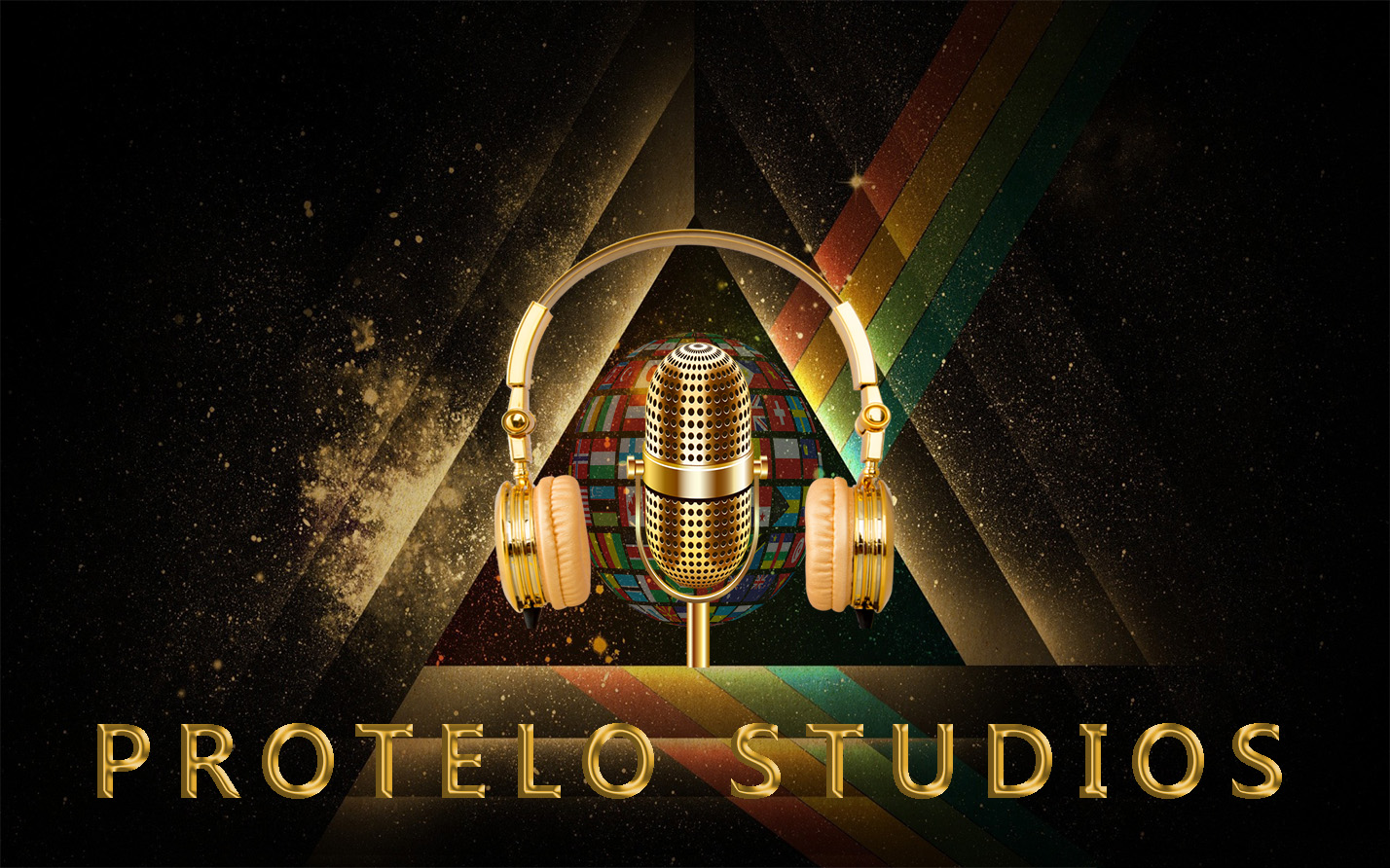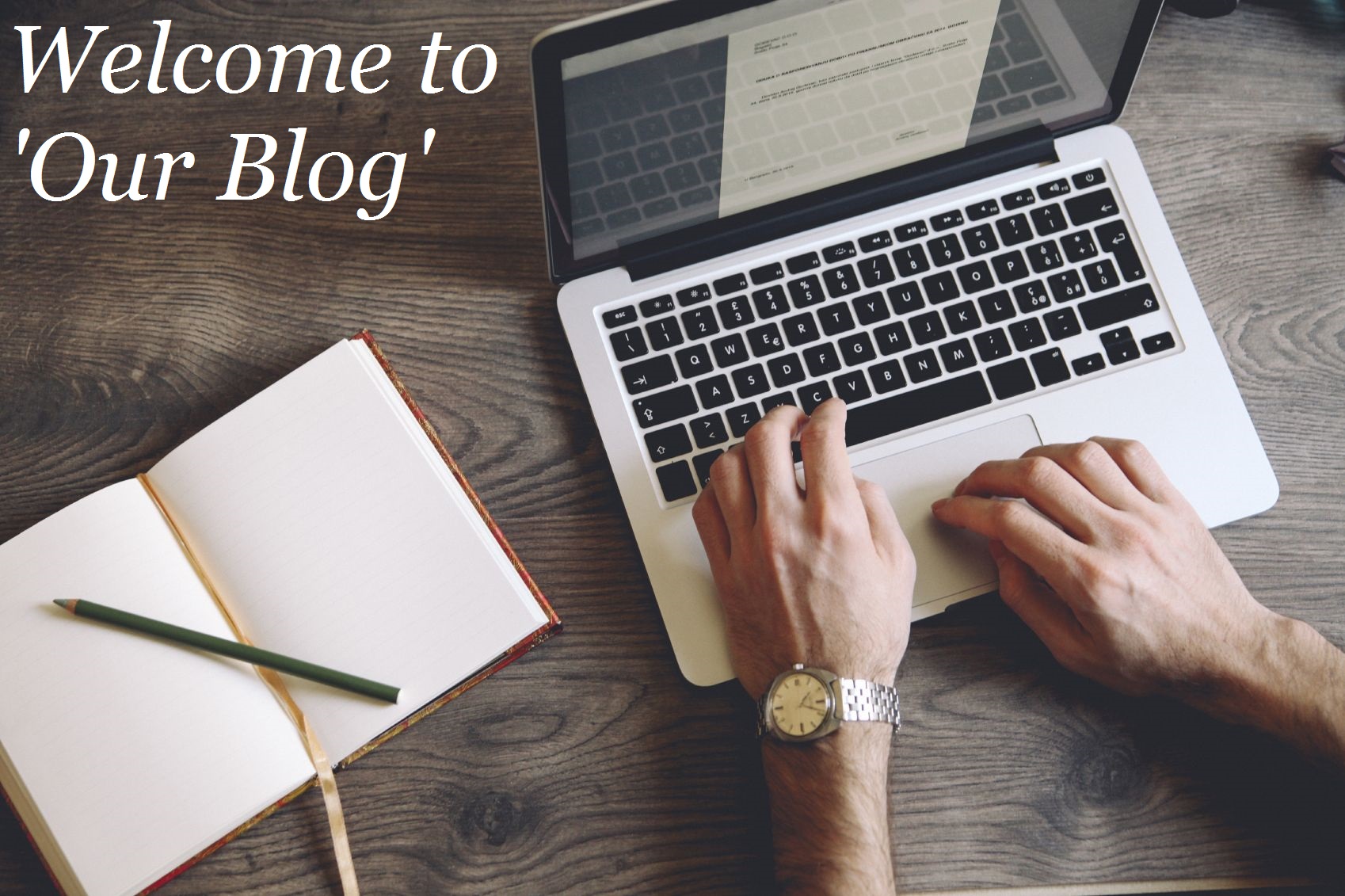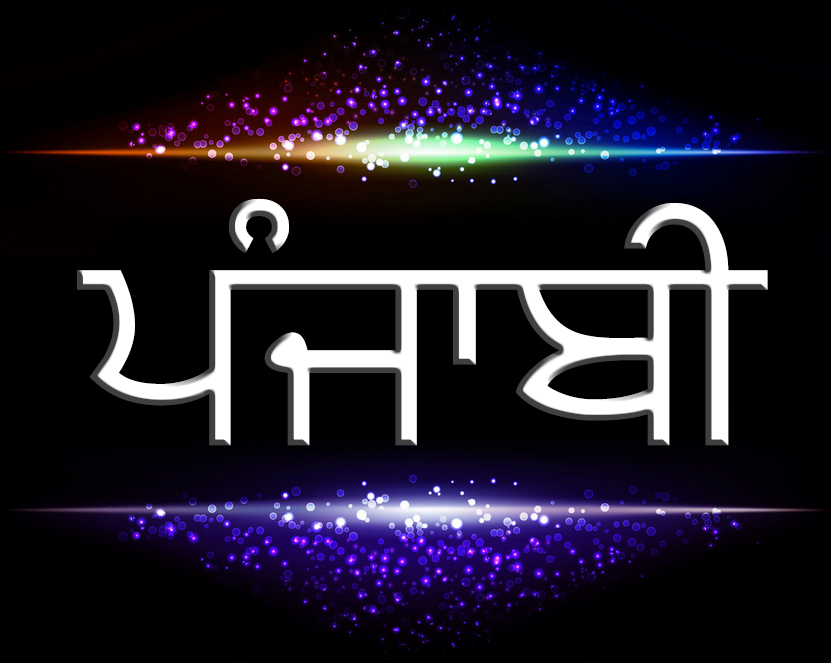
AuthorLayamika DuttaUpdated on CategoriesLanguages
‘Punjabi’ (ਪੰਜਾਬੀ) – THE HISTORY:
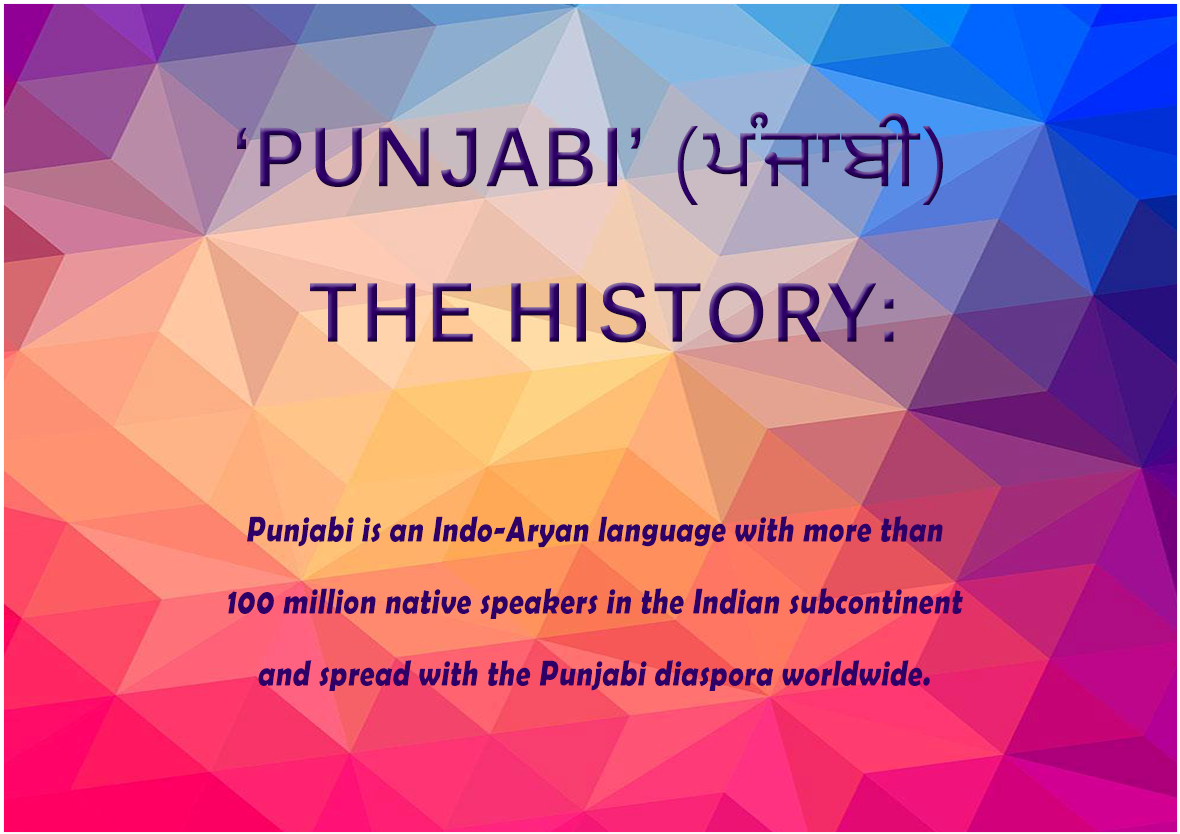
About the language:
It is the native language of
the Punjabi people, an ethnic group of the cultural region of Punjab region of the Indian subcontinent, which extends from northwest India
through eastern Pakistan. Punjabi is the most widely spoken language in Pakistan, the 11th most widely spoken language in India, and the third most-spoken native language in the Indian Subcontinent. In Canada, it is the fifth most-spoken native language, after English, French, Mandarin and Cantonese. It has a significant presence in the United Arab Emirates, the United States, the United Kingdom, Australia, New Zealand, Italy, and the Netherlands.
Punjabi is unusual among Indo-European languages in its use of lexical tone (that is, the way in which the pitch of the voice conveys meaning). The Punjabi language is written in one of two alphabets: Shahmukhi or Gurmukhi. Shahmukhi is used mainly by Punjabi Muslims, and Gurmukhi is used mainly by Punjabi Sikhs and Hindus.
The Janamsakhis (ਜਨਮਸਾਖੀ), stories on the life and legend of Guru Nanak (1469–1539), are early examples of Punjabi prose literature.
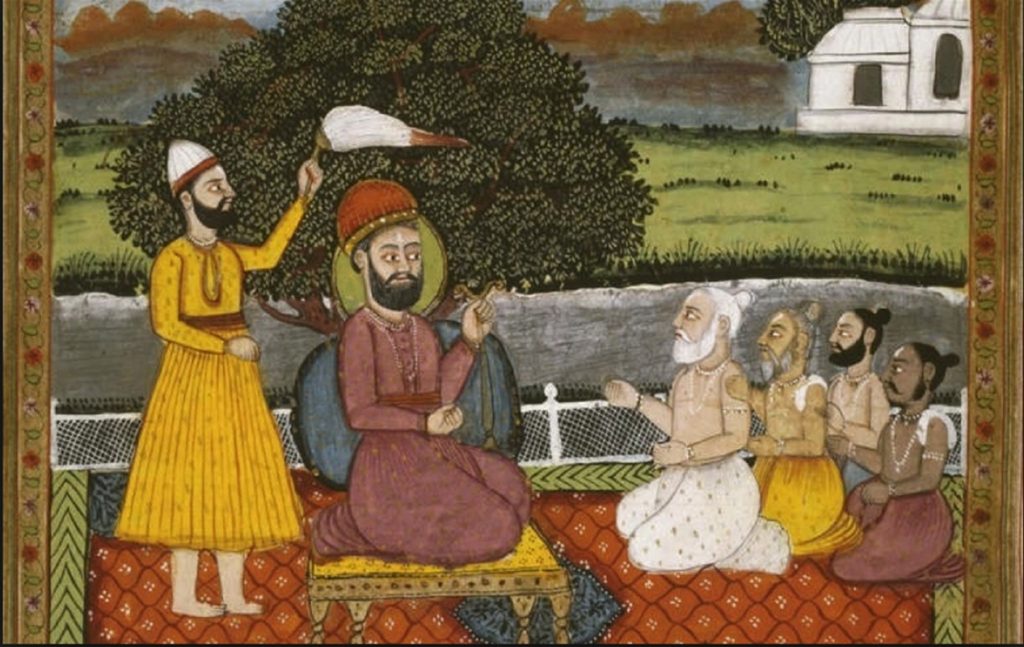
History:
Etymology
The word Punjabi has been derived from the word Panj-āb, introduced by Turko-Persian speakers, Persian for “Five Waters”, referring to the five major eastern tributaries of the Indus River. Panj is cognate with Sanskrit पञ्च (pañca) and Greek πέντε (pénte) “five”, and “āb” is cognate with Sanskrit अप् (áp) and with the Av- of Avon. The historical Punjab region, now divided between India and Pakistan, is defined physiographically by the Indus River and these five tributaries. One of the five, the Beas River, is a tributary of another, the Sutlej.
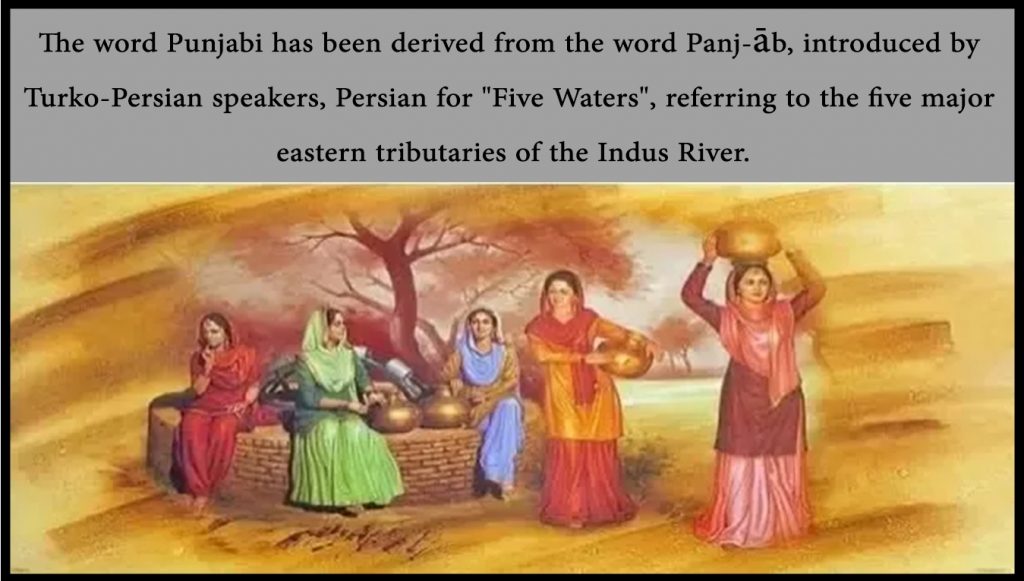
Origin
Punjabi developed from Sanskrit through Prakrit languages and later Apabhraṃśa (Sanskrit: अपभ्रंश; corruption or corrupted speech) From 600 BC Sanskrit gave birth to many regional languages in different parts of India. All these languages are called Prakrit (Sanskrit: प्राकृत prākṛta) collectively. Shauraseni Prakrit was one of these Prakrit languages, which was spoken in north and north-western India and Punjabi and western dialects of Hindi developed from this Prakrit. Later in northern India Shauraseni Prakrit gave rise to Shauraseni Aparbhsha, a descendent of Prakrit. Punjabi emerged as an Apabhramsha, a degenerated form of Prakrit, in the 7th century A.D. and became stable by the 10th century. By the 10th century, many Nath poets were associated with earlier Punjabi works.
Arabic and Persian influence on Punjabi
Arabic and Persian influence in the historical Punjab region began with the late first millennium Muslim conquests on the Indian subcontinent. The Persian language was introduced in the subcontinent a few centuries later by various Turko-Persian dynasties. Many Persian and Arabic words were incorporated in Punjabi. It is noteworthy that the Hindustani language is divided into Hindi, with more Sanskritisation, and Urdu, with more Persianisation, but in Punjabi both Sanskrit and Persian words are used with a liberal approach to language. Later, it was influenced by Portuguese and English, though these influences have been minor in comparison to Persian and Arabic. However, in India, English words in the official language are more widespread than Hindi.
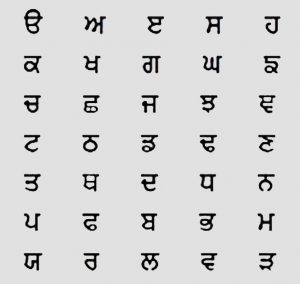

Geographic distribution
Punjabi is the most widely spoken language in Pakistan, the eleventh -most widely spoken in India and spoken Punjabi diaspora in various countries.
Pakistan
Punjabi is the most widely spoken language in Pakistan, being the native language of 44% of its population. It is the provincial language in the Punjab Province. Beginning with the 1981 census, speakers of Saraiki and Hindko were no longer included in the total numbers for Punjabi, which could explain the apparent decrease.
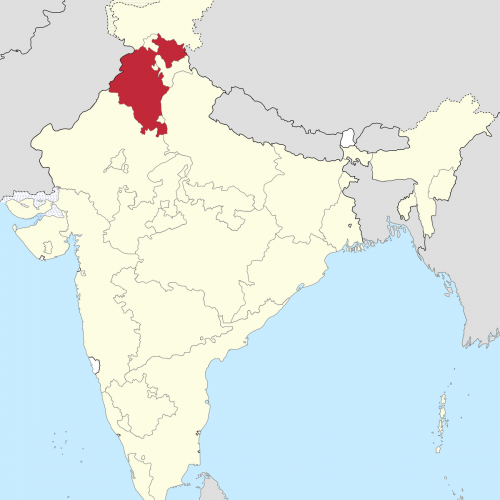
India
Punjabi is spoken as a native language, second language, or third language by about 30 million people in India. Punjabi is the official language of the Indian states of Punjab, Haryana and Delhi. Some of its major urban centres in northern India are Ambala, Ludhiana, Patiala, Amritsar, Chandigarh, Jalandhar, Bathinda and Delhi.
Punjabi diaspora
Punjabi is also spoken as a minority language in several other countries where Punjabi people have emigrated in large numbers, such as the United States, Australia, the United Kingdom, and Canada, where it is the fourth-most-commonly used language. There were 76 million Punjabi speakers in Pakistan in 2008, 33 million in India in 2011, 368,000 in Canada in 2006, and smaller numbers in other countries.
Official status
Despite Punjabi’s rich literary history, it was not until 1947 that it would be recognized as an official language. Previous governments in the area of the Punjab had favoured Persian, Hindustani, or even earlier standardised versions of local registers as the language of the court or government. After the annexation of the Sikh Empire by the British East India Company following the Second Anglo-Sikh War in 1849, the British policy of establishing a uniform language for administration was expanded into the Punjab. The British Empire employed Hindi and Urdu in its administration of North-Central and North-West India, while in the North-East of India, Bengali was used as the language of administration. Despite its lack of official sanction, the Punjabi language continued to flourish as an instrument of cultural production, with rich literary traditions continuing until modern times. The Sikh religion, with its Gurmukhi script, played a special role in standardising and providing education in the language via Gurdwaras, while writers of all religions continued to produce poetry, prose, and literature in the language.
In India, Punjabi is one of the 22 scheduled languages of India. It is the first official language of the Indian State of Punjab. Punjabi also has second language official status in Delhi along with Urdu, and in Haryana. In Pakistan, no regional ethnic language has been granted official status at the national level, and as such Punjabi is not an official language at the national level, even though it is the most spoken language in Pakistan after Urdu, the national language of Pakistan. It is, however, the official provincial language of Punjab, Pakistan, the second largest and the most populous province of Pakistan as well as in Islamabad Capital Territory. The only two official national languages in Pakistan are Urdu and English, which are considered the lingua francas of Pakistan.

Modern Punjabi
Standard Punjabi
•Punjabi is spoken in many dialects in an area from Islamabad to Delhi. The Majhi dialect has been adopted as standard Punjabi in Pakistan and India for education, media etc. The Majhi (in Shahmukhi ماجھی، in Gurmukhi ਮਾਝੀ) dialect originated in the Majha region of the Punjab. The Majha region consists of several eastern districts of Pakistani Punjab and in India around Amritsar, Gurdaspur, and surrounding districts. The two most important cities in this area are Lahore and Amritsar.
•In India technical words in Standard Punjabi are loaned from Sanskrit similarly to other major Indian languages, but it generously uses Arabic, Persian, and English words also in the official language. In India, Punjabi is written in the Gurmukhī script in offices, schools, and media. Gurmukhi is the official standard script for Punjabi, though it is often unofficially written in the Devanagari or Latin scripts due to influence from Hindi and English, India’s two primary official languages at the Union-level.
•In Pakistan, Punjabi is generally written using the Shahmukhī script, created from a modification of the Persian Nastaʿlīq script. In Pakistan, Punjabi loans technical words from Persian and Arabic languages, just like Urdu does.
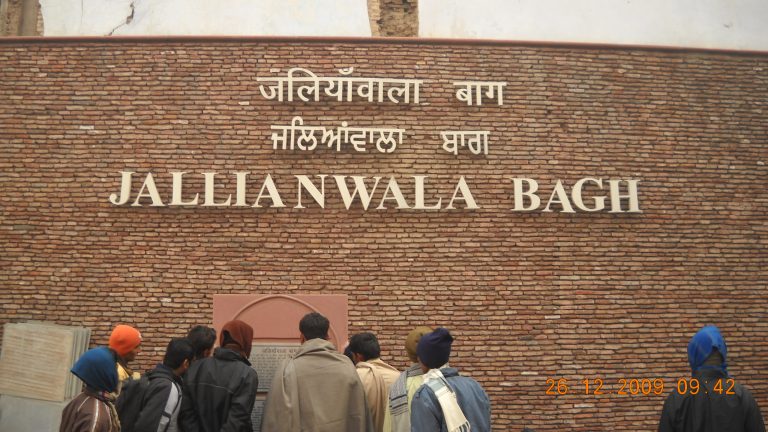
Major dialects
Majhi (Standard Punjabi)
The Majhi (ماجھی ਮਾਝੀ /’má:d͡ʒi:/) dialect spoken around Amritsar and Lahore is Punjabi’s prestige dialect. Majhi is spoken in the heart of Punjab in the region of Majha, which spans Lahore, Amritsar, Gurdaspur, Kasur, Tarn Taran, Faisalabad, Nankana Sahib, Pathankot, Okara, Pakpattan, Sahiwal, Narowal, Sheikhupura, Sialkot, Chiniot, Gujranwala and Gujrat and in Mandi Bahauddin(97’/.) districts.
Shahpuri
Shahpuri dialect (also known as Sargodha dialect) is mostly spoken in Pakistani Punjab. Its name is derived from former Shahpur District (now Shahpur Tehsil, being part of Sargodha District). It is spoken throughout a widespread area, spoken in Sargodha and Khushab Districts and also spoken in neighbouring Mianwali and Bhakkar Districts. It is mainly spoken on western end of Sindh River to Chennab river crossing Jehlam river.
Malwai
Malwai is spoken in the southern part of Indian Punjab and also in Bahawalnagar and Vehari districts of Pakistan. Main areas are Barnala, Ludhiana, Patiala, Ambala, Bathinda, Mansa, Ganganagar, Malerkotla, Fazilka, Ferozepur, Moga. Malwa is the southern and central part of present-day Indian Punjab. It also includes the Punjabi speaking northern areas of Haryana, viz. Ambala, Hissar, Sirsa, Kurukshetra, Narnaul etc. Not to be confused with the Malvi language, which shares its name.
Doabi
Doabi is spoken in both the Indian Punjab as well as parts of Pakistan Punjab owing to post-1947 migration of Muslim populace from East Punjab. The word “Do Aabi” means “the land between two rivers” and this dialect was historically spoken between the rivers of the Beas and the Sutlej in the region called Doaba. Regions it is presently spoken includes the Jalandhar, Hoshiarpur and Kapurthala districts in Indian Punjab, specifically in the areas known as the Dona and Manjki, as well as the Toba Tek Singh and Faisalabad districts in Pakistan Punjab where the dialect is known as Faisalabadi Punjabi.
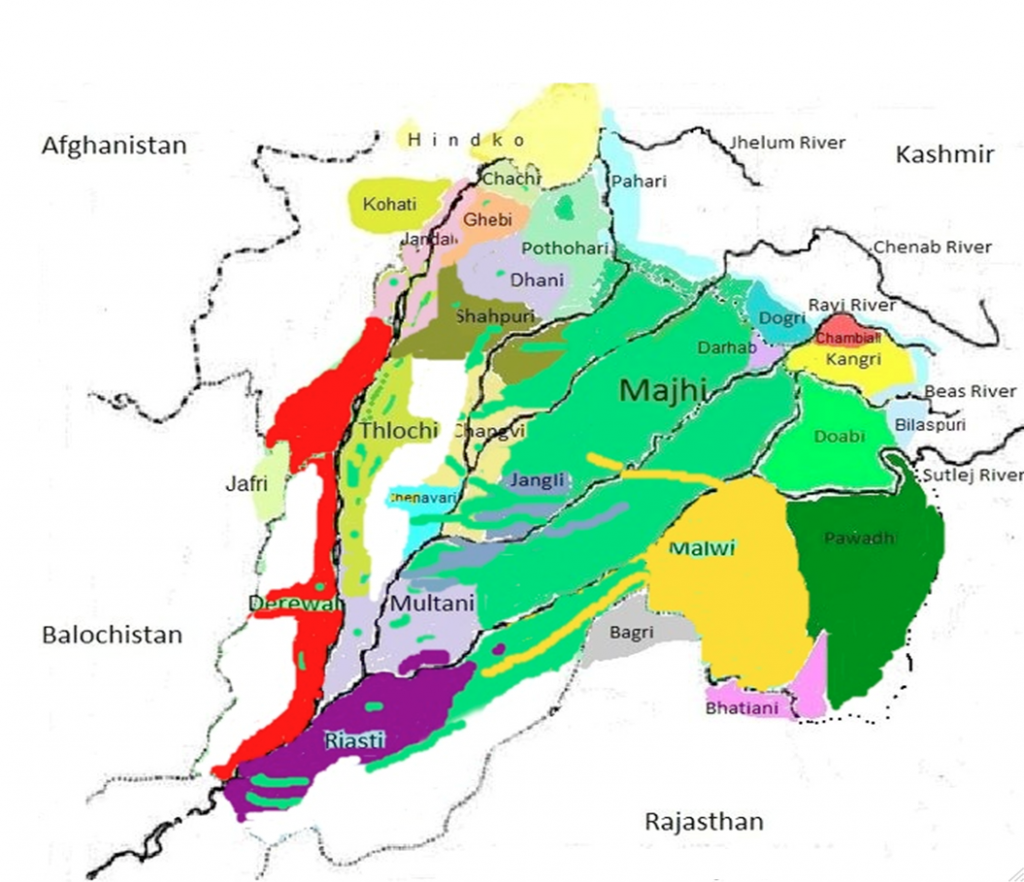
Puadhi
Puadh is a region of Punjab and parts of Haryana between the Satluj and Ghaggar rivers. The part lying south, south-east and east of Rupnagar adjacent to Ambala District (Haryana) is Puadhi. The Puadh extends from that part of the Rupnagar District which lies near Satluj to beyond the Ghaggar river in the east up to Kala Amb, which is at the border of the states of Himachal pradesh and Haryana. Parts of Fatehgarh Sahib district, and parts of Patiala districts like Rajpura are also part of Puadh. The Puadhi dialect is spoken over a large area in present Punjab as well as Haryana. In Punjab, Kharar, Kurali, Ropar, Nurpurbedi, Morinda, Pail, Rajpura and Samrala are areas where Puadhi is spoken and the dialect area also includes Pinjore, Kalka, Ismailabad, Pehowa to Bangar area in Fatehabad district.
Jhangochi/Changvi
Jhangochi (جھنگوچی) dialect is spoken in Pakistani Punjab throughout a widespread area, starting from Khanewal and Jhang at both ends of Ravi and Chenab to Hafizabad district.
Jangli/Rachnavi
Jangli is a dialect of former nomad tribes of areas whose names are often suffixed with ‘Bar’ derived from jungle bar before irrigation system arrived in the start of the 20th century, for example, Sandal Bar, Kirana Bar, Neeli Bar, Ganji Bar. Former Layllpur and western half of Montgomary district used to speak this dialect.
Chenavari
West of Chenaab river in Jhang district of Pakistani Punjab the dialect of Jhangochi merges with Thalochi and resultant dialect is Chenavari. Name is derived from Chenaab river.
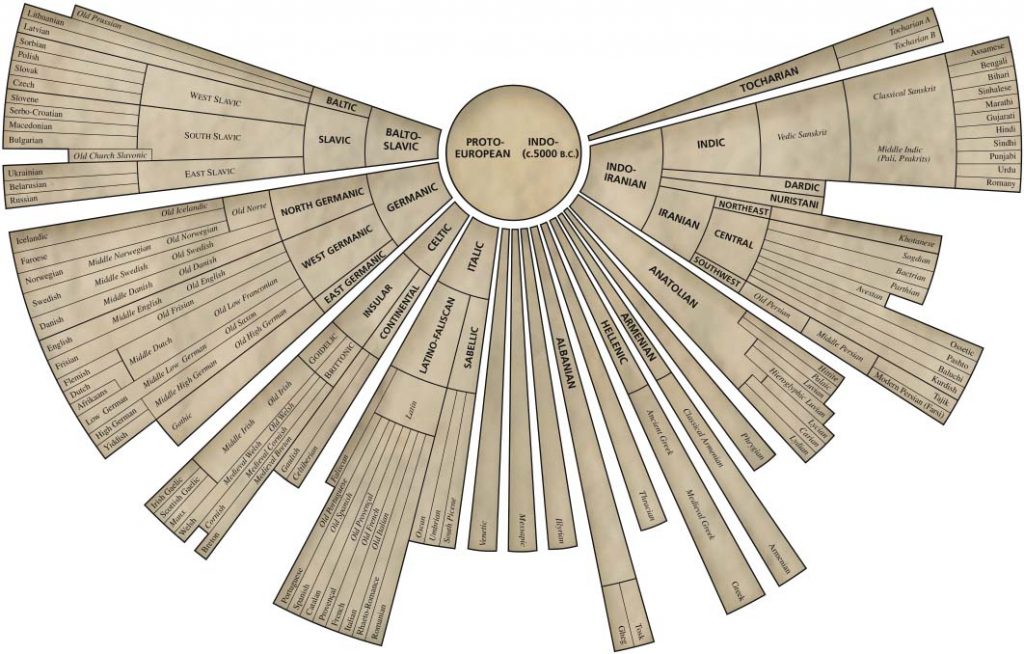
Grammar
The grammar of the Punjabi language concerns the word order, case marking, verb conjugation, and other morphological and syntactic structures of the Punjabi language. The main article discusses the grammar of Modern Standard Punjabi as defined by the sources cited therein.
Writing systems
Punjabi has two major writing systems in use: Gurmukhī, which is a Brahmic script derived from the Laṇḍā script, and Shahmukhi, which is an Arabic script. The word Gurmukhi means “from the Guru’s mouth”, and Shahmukhi means “from the King’s mouth”.
In the Punjab province of Pakistan, the script used is Shahmukhī and differs from the Urdu alphabet in having four additional letters. In the Indian states of Punjab, Haryana and Delhi and other parts of India, the Gurmukhī script is generally used for writing Punjabi. Historically, various local Brahmic scripts including Laṇḍā were also in use.
Literature development
Medieval era, Mughal and Sikh period
•The earliest Punjabi literature is found in the fragments of writings of the 11th Nath yogis (ਨਾਥਯੋਗੀ) Gorakshanath and Charpatnah which is primarily spiritual and mystical in tone.
•Fariduddin Ganjshakar (1179-1266) is generally recognised as the first major poet of the Punjabi language. Roughly from the 12th century to the 19th century, many great Sufi saints and poets preached in the Punjabi language, the most prominent being Bulleh Shah. Punjabi Sufi poetry also developed under Shah Hussain (1538–1599), Sultan Bahu (1630–1691), Shah Sharaf (1640–1724), Ali Haider (1690–1785), Waris Shah (1722–1798), Saleh Muhammad Safoori (1747-1826), Mian Muhammad Baksh (1830-1907) and Khwaja Ghulam Farid (1845-1901).
•The Sikh religion originated in the 15th century in the Punjab region and Punjabi is the predominant language spoken by Sikhs. Most portions of the Guru Granth Sahib use the Punjabi language written in Gurmukhi, though Punjabi is not the only language used in Sikh scriptures.
•The Punjabi language is famous for its rich literature of qisse (ਕਿੱਸੇ,), most of the which are about love, passion, betrayal, sacrifice, social values and a common man’s revolt against a larger system. The qissa of Heer Ranjha by Waris Shah (1706–1798) is among the most popular of Punjabi qissas. Other popular stories include Sohni Mahiwal by Fazal Shah, Mirza Sahiban by Hafiz Barkhudar (1658–1707), Sassui Punnhun by Hashim Shah (c. 1735–c. 1843), and Qissa Puran Bhagat by Qadaryar (1802–1892).
•Heroic ballads known as Vaar (ਵਾਰ,) enjoy a rich oral tradition in Punjabi. Famous Vaars are Chandi di Var (1666–1708), Nadir Shah Di Vaar by Najabat and the Jangnama of Shah Mohammad (1780–1862).
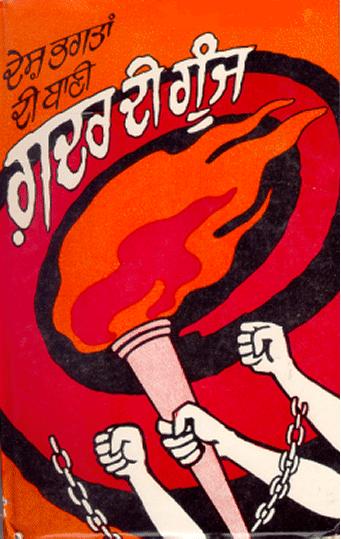
British Raj era and post-independence period
•The Victorian novel, Elizabethan drama, free verse and Modernism entered Punjabi literature through the introduction of British education during the Raj.
•Nanak Singh (1897–1971), Vir Singh, Ishwar Nanda, Amrita Pritam (1919–2005), Puran Singh (1881–1931), Dhani Ram Chatrik (1876–1957), Diwan Singh (1897–1944) and Ustad Daman (1911–1984), Mohan Singh (1905–78) and Shareef Kunjahi are some legendary Punjabi writers of this period.
•After independence of Pakistan and India Najm Hossein Syed, Fakhar Zaman and Afzal Ahsan Randhawa, Shafqat Tanvir Mirza, Ahmad Salim, and Najm Hosain Syed, Munir Niazi, Pir Hadi abdul Mannan enriched Punjabi literature in Pakistan, whereas Amrita Pritam (1919–2005), Jaswant Singh Rahi (1930–1996), Shiv Kumar Batalvi (1936–1973), Surjit Patar (1944–) and Pash (1950–1988) are some of the more prominent poets and writers from India.
In India
At the federal level, Punjabi has official status via the Eighth Schedule to the Indian Constitution, earned after the Punjabi Suba movement of the 1950s. At the state level, Punjabi is the sole official language of the state of Punjab, while it has secondary official status in the states of Haryana and Delhi.
Both federal and state laws specify the use of Punjabi in the field of education. The state of Punjab uses the Three Language Formula, and Punjabi is required to be either the medium of instruction, or one of the three languages learnt in all schools in Punjab. Punjabi is also a compulsory language in Haryana, and other states with a significant Punjabi speaking minority are required to offer Punjabi medium education.
There are vibrant Punjabi language movie and news industries in India, however Punjabi serials have had a much smaller presence within the last few decades in television due to market forces. Despite Punjabi having far greater official recognition in India, “where the Punjabi language is officially admitted in all necessary social functions, while in Pakistan it is used only in a few radio and TV programs,” attitudes of the English-educated elite towards the language are ambivalent as they are in neighboring Pakistan. There are also claims of state apathy towards the language in non-Punjabi majority areas like Haryana and Delhi.
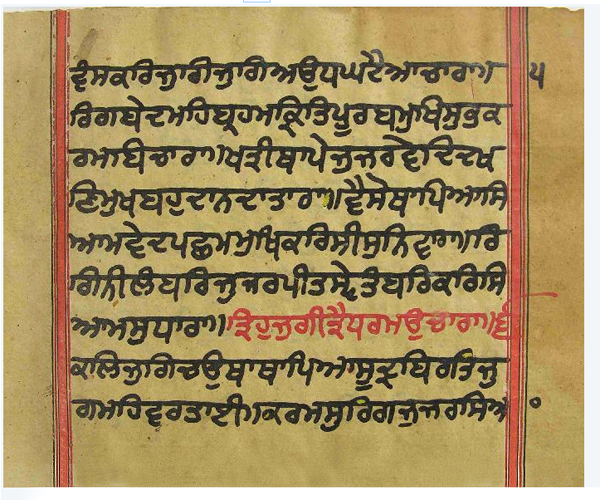
In Pakistan
When Pakistan was created in 1947, although Punjabi was the majority language in West Pakistan and Bengali the majority in East Pakistan and Pakistan as whole, English and Urdu were chosen as the national languages. The selection of Urdu was due to its association with South Asian Muslim nationalism and because the leaders of the new nation wanted a unifying national language instead of promoting one ethnic group’s language over another. Broadcasting in Punjabi language by Pakistan Broadcasting Corporation decreased on TV and radio after 1947. Article 251 of the Constitution of Pakistan declares that these two languages would be the only official languages at the national level, while provincial governments would be allowed to make provisions for the use of other languages. However, in the 1950s the constitution was amended to include the Bengali language. Eventually, Punjabi was granted status as a provincial language in Punjab Province, while the Sindhi language was given official status in 1972 after 1972 Language violence in Sindh.
Despite gaining official recognition at the provincial level, Punjabi is not a language of instruction for primary or secondary school students in Punjab Province (unlike Sindhi and Pashto in other provinces). Pupils in secondary schools can choose the language as an elective, while Punjabi instruction or study remains rare in higher education. One notable example is the teaching of Punjabi language and literature by the University of the Punjab in Lahore which began in 1970 with the establishment of its Punjabi Department.
In the cultural sphere, there are many books, plays, and songs being written or produced in the Punjabi-language in Pakistan. Until the 1970s, there were a large number of Punjabi-language films being produced by the Lollywood film industry, however since then Urdu has become a much more dominant language in film production. Additionally, television channels in Punjab Province (centred on the Lahore area) are broadcast in Urdu. The preeminence of Urdu in both broadcasting and the Lollywood film industry is seen by critics as being detrimental to the health of the language.
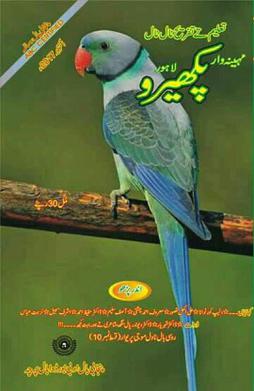
Language demands in Punjab province
The use of Urdu and English as the near exclusive languages of broadcasting, the public sector, and formal education have led some to fear that Punjabi in Pakistan is being relegated to a low-status language and that it is being denied an environment where it can flourish. Several prominent educational leaders, researchers, and social commentators have echoed the opinion that the intentional promotion of Urdu and the continued denial of any official sanction or recognition of the Punjabi language amounts to a process of “Urdu-isation” that is detrimental to the health of the Punjabi language.
In August 2015, the Pakistan Academy of Letters, International Writer’s Council (IWC) and World Punjabi Congress (WPC) organised the Khawaja Farid Conference and demanded that a Punjabi-language university should be established in Lahore and that Punjabi language should be declared as the medium of instruction at the primary level. In September 2015, a case was filed in Supreme Court of Pakistan against Government of Punjab, Pakistan as it did not take any step to implement the Punjabi language in the province. Additionally, several thousand Punjabis gather in Lahore every year on International Mother Language Day.

Hafiz Saeed, chief of Jama’at-ud-Da’wah (JuD) has questioned Pakistan’s decision to adopt Urdu as its national language in a country where majority of people speak Punjabi language, citing his interpretation of Islamic doctrine as encouraging education in the mother-tongue. The list of thinktanks, political organisations, cultural projects, and individuals that demand authorities at the national and provincial level to promote the use of the language in the public and official spheres includes:
•Cultural and research institutes:
Punjabi Adabi Board, the Khoj Garh Research Centre, Punjabi Prachar, Institute for Peace and Secular Studies, Adbi Sangat, Khaaksaar Tehreek, Saanjh, Maan Boli Research Centre, Punjabi Sangat Pakistan, Punjabi Markaz, Sver International.
•Trade unions and youth groups:
Punjabi Writers Forum, National Students Federation, Punjabi Union-Pakistan, Punjabi National Conference, National Youth Forum, Punjabi Writers Forum, National Students Federation, Punjabi Union, Pakistan, and the Punjabi National Conference.
•Notable activists include:
Tariq Jatala, Farhad Iqbal, Diep Saeeda, Khalil Ojla, Afzal Sahir, Jamil Ahmad Paul, Mazhar Tirmazi, Mushtaq Sufi, Biya Je, Tohid Ahmad Chattha and Bilal Shaker Kahaloon, Nazeer Kahut.
